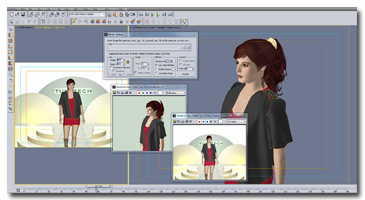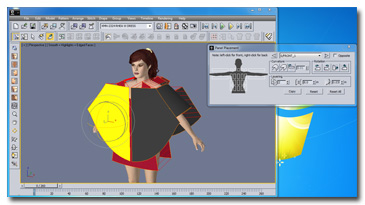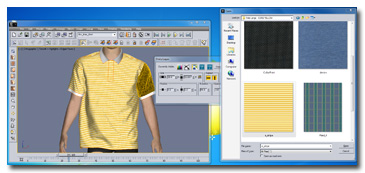Technology advancements have allowed companies in virtually every industry to streamline their
product development processes, and the apparel industry is no exception. Processes such as pattern
making, pattern grading, and marker making have all been automated using computer-aided design
(CAD) software. But what about sample development — one of the most time-consuming and costly
components of product development? Well, now 3-D technology offers the apparel industry several
opportunities to streamline sample processes. By producing 3-D samples, apparel companies can save
time and money, better meet buyer demands and more quickly respond to consumer trends.

Using 3-D sample-making software, images and movie files can be used as a background for
rendering.
First, let’s talk about what the current production cycle looks like. It’s no secret that the
majority of apparel manufacturing happens outside of the United States. And while apparel companies
save production costs by sourcing to overseas manufacturers, they lose quite a bit of time in the
product development process. The iterative sample approval process can involve weeks, sometimes
even months, of sending physical samples back and forth from manufacturer to buyer. This process
can restrict a company from getting a particular style in stores at the peak of demand for that
particular trend. In this era of fast fashion, it’s very important for apparel companies to be able
to design and develop new production-ready styles as fast as possible.
But, of course, apparel companies cannot simply stop producing samples. Whether they are
building an airplane engine, a circuit board or a building, all designers and engineers go through
a similar process of design, prototype development, final approval and then production. But how did
Ford manage to build competitive transmissions faster and cheaper, and how does Intel manage to
constantly develop new products to meet software demands? The answer lies in 3-D software.

Pattern pieces are arranged on a virtual model using a silhouette placement tool.
The entire engineering world has been using 3-D software for more than a decade to design 3-D
prototypes of everything from cars to computer chips. Now that 3-D software has emerged as a real
solution in the apparel industry, more and more companies are building fewer physical samples from
real fabric and shipping them to the design houses. Rather, manufacturers and designers are working
and communicating in a more digital way to make and approve a 3-D virtual or digital sample of the
garment. But how does it work? Drafted CAD pattern pieces, modeled to behave as fabric using
sophisticated cloth simulation physics, are placed around an avatar and sewn together inside of the
3-D software. The cloth simulation is applied to realistically reproduce the proper drape and fit.
Then, the software user can save the 3-D sample as an image or movie from any perspective, and with
or without animation of a virtual model “wearing” the virtual sample. The sample can be emailed,
providing designers, fit technicians, and executives the ability to evaluate a sample long before
it would have been cut and sewn into a real sample.
Eliminating physical samples saves apparel companies not only time, but also money. Many
times, the sample garment will need additional corrections or adjustments, and the buyer will
request the vendor to make those adjustments, and then cut, sew and ship a revised sample.
Moreover, many of these samples never make it to production for reasons that have nothing to do
with fit or construction, but rather with the natural selection process design houses go through in
creating a collection for a line. However, by utilizing 3-D samples, the software user can make any
necessary changes to the garment before it is ever sewn, saving on sample fabric costs, shipping
costs, fit model costs and, of course, speeding up the entire process.

Prints, logos and other visual effects can be applied to any part of a 3-D garment.
Once the 3-D sample is approved, the value of the data still remains. Companies are using 3-D
samples in their sales processes with buyers. Because 3-D samples can be created in an infinite
number of colors and prints, buyers can be presented with a number of options without manufacturers
having to invest in a physical sample that might never even make it into production. Companies like
Velvet Heart, Green Apple, and others are displaying virtual samples on flat screens on the
showroom floor or at trade shows, such as the recent Magic Marketplace in Las Vegas. Advanced 3-D
systems also offer virtual animation, allowing users and collaborators to evaluate the sample in
any pose and with any kind of movement. For example, buyers can watch a soccer jersey sample’s
fabric and fit perform as a virtual model kicks a ball.
As you can see, 3-D sample-making software can be used in various ways in the supply chain to
reduce lead times, increase quality, and dramatically lower costs. Vendors for brands such as Maggy
London, Tesco, Phillip Van Heusen, Abercrombie & Fitch and Jones New York Intimates use 3-D
sample-making software, and even more industry-leading brands are expected to adopt the technology
in the near future.
Editor’s note: Ram Sareen is CEO-founder of Tukatech Inc., a Los Angeles-based
provider of apparel industry software, including the TUKA3D virtual sample-making system;
pattern-making, grading and marker-making software; Web-based product development services; product
data management/product lifecycle management systems; and manufacturing equipment supported by
brick-and-mortar centers strategically located in garment hubs worldwide.
October 19, 2010




